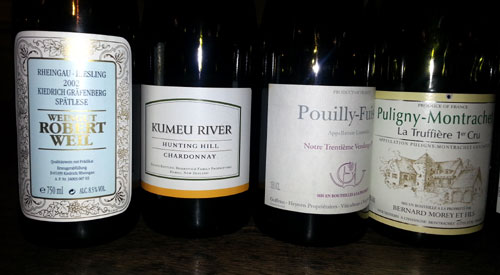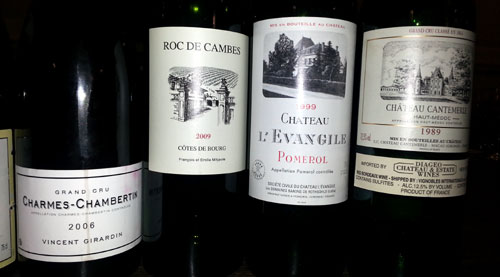In what has now become a yearly return to the Oxford Blind Tasting Society, I've become used to the ability of the tasters to divine wines' origins from around the world. I have tried to trick and outsmart their palates before, but invariably someone always guesses my Viognier has come from New Zealand or my Riesling from Austria. So, with that in mind I went for a slightly more conventional line up with some favourite wines from the Farr cellar, focusing more on the intricacies of guessing - which vintage or village and why, and how to identify specifics.

Balliol college, founded in 1263, was the venue selected
|
It was also a good excuse to bring some wines that I wanted to drink! Tom Arnold, who is now the President of the society, set up a room in Balliol College with 20 keen palates and sharp minds who are now starting to think about the next Varsity Blind Tasting against Cambridge in early 2014. Even though I was asking difficult questions on the finer details, I was very impressed by the accuracy of guessing. The wines were served blind (the reds in decanters so as to disguise any bottle shape hints), in two flights of four.
Kiedricher Grafenburg Spatlese, Robert Weil, 2002
1,100 cases were made of this wine from the Robert Weil estate, now run by fourth generation Willhelm Weil in the heart of Kiedrich in the Rheingau. Medium lemon in colour, the nose is sweet with apples and peaches, plenty of candied citrus peel and a hint of petrol. The palate has a rich, sweet entry that is pierced by high acidity and lots of ripe stone fruit. Hints of marmalade suggest a touch of botrytis. The long finish is floral and lifted with more of that slight petrol note. There is a lingering, balancing sweetness.
Almost everyone was immediately in Germany and guessing Riesling, and guesses split between Auslese and Spatlese impressed. I was also impressed that many were at roughly 10-12 years old. I didn't really have much to teach here, they were all so close already! 2002 was a vintage that produced a fair amount of botrytis and the Rheingau is slightly riper than the Mosel, the two little hints I would give to get closer, but when tasting one Riesling in isolation, it is hard to argue that anyone wouldn't receive close to top marks for their guesses.

The whites in their glasses, bottles covered in the background
|
Hunting Hill Chardonnay, Kumeu River, 2007
The Hunting Hill has critical acclaim with 94 from both Neal Martin and Lisa Perrotti-Brown MW and 18 points from Julia Harding MW. This seems justified as soon as you take a sniff. Rich buttery oak and cream is balanced by fresh stone fruit that is still vibrant at this age. With more air the oak integrates further and creamy peaches and pears come through. The palate is intense with lots of stone fruit refreshed by balancing acidity and a steely backbone. Toasted spices on the long finish from the oak. Absolutely delicious but I was surprised how youthful the wine still is!
I like putting Kumeu River in blind tastings, particularly the Hunting Hill, as people always end up guessing Burgundy. Most calls were for Meursault and a few for Puligny and similar, though there were one or two calling for Australia. New Zealand was absent, though I suppose it does in a way fall between the two. A few knowing groans emerged when I told them, as I've played this trick on some before! Guessers were also surprised at the age, many were in 2010 or 2009 and some in 2008.
Pouilly Fuissé Cuvée Trentième Vendange, Guffens-Heynen, 2009
This cuvée from Jean-Marie Guffens is from three plots in Vergisson (La Roche, Les Croux and Les Crays). The wine is incredibly creamy, with lots of ripe stone fruit and a slight bready note. There is no obvious new oak here. The palate is warm and full of ripe fruit and cream, but still with a balancing acidity that seems higher than most in 2009. Lots of fresh peaches and cream with a rich and round finish.
I inadvertently fooled many with this, perhaps because they didn't expect three Chardonnays in a row, but after revealing the wine it made sense. A Maconnais with little hint of new oak treatment from a ripe Burgundy vintage. The wine is delicious and fruit forward, and like many white Burgundies from 2009 is drinking really well now.
Puligny-Montrachet La Truffière, Bernard Morey, 2001
Puligny-Montrachet is known for its precision and steely backbone. La Truffière is a 2.48 hectare vineyard just above and to the right of the Folatières vineyard. This wine was initially a little reserved on the nose, but with air revealed lots of sharp citrus fruit, apples and pears. There is a creaminess and earthiness that hints at the development of the wine too. There are hints of spice from oak but it is well integrated. The palate is elegant, precise and cool. Spice from the oak melds with white pear and honeyed citrus with time in the glass and as you delve further into its complexities.
Everyone was in Burgundy for this one as far as I remember. Some were saying aged Premier/Grand Cru Chablis, and lots of people were in the areas surrounding Puligny. One guess was spot on with 2001 Puligny, which was very impressive. Many guessed 2002 which has a better reputation in Burgundy and highlighted the quality of this wine.

The white wines revealed
|
The whites seemed to go down very well, but the most popular was the Weil Riesling. A few were also in the Puligny camp. The Weil is perhaps more enjoyable but the Puligny more complex and serious. The reds I thought were a touch easier, but that's only the case if you know!
Charmes Chambertin, Vincent Girardin, 2006
The second vintage made by Girardin. The wine is still a bright ruby in appearance. Raspberries, strawberries, vanilla and spice on the nose. Quite fresh with floral, violet notes. The palate has fresh, clean red cherries and raspberries, soft and supple tannins, and sweet vanilla. The wine is supple and silky, and is drinking very well already. The palate is intense but not weighty, and the finish is long.
Everyone was close here and I heard more than one call for Premier Cru Gevrey Chambertin from both 2005 and 2007. 2006s fell in the wake of the great 2005s, but now they have some bottle age are providing some delicious early drinking with pure fruit and soft tannins.
Roc de Cambes 2009
Farr have been fans of Francois Mitjaville's Cotes de Bourg for a long time. The Tertre Roteboeuf producer's knack for making intense but balanced wines from this satellite right bank appellation are shown off with this 2009. Deep purple/ruby to the rim, the nose is rich, ripe and opulent with cassis, liquorice, and soy lifted by an almost violet floral note. The palate is big and muscular, oodles of black fruit fight with toasted spices and sweet vanilla, structured by balancing acidity and ripe tannins. The wine is full bodied and intense, with a very long finish. Superb.
This wine threw a lot of people as it is just so rich and intense, but still with such great structure. However, spying on Tom's notes as he sat next to me, I saw him still correctly identify right bank 2009. As soon as I said that this wine was right bank 2009 but not Pomerol or Saint Emilion, more groans from some of the room were accompanied by 'of course it's Roc de Cambes'. But, a hard one to guess right, as it stands alone in the Cotes de Bourg in terms of quality and style.
Chateau L'Evangile 1999
Situated between Petrus, Cheval Blanc, Conseillante and Gazin, the now Rothschild owned vineyards of L'Evangile are situated perfectly for growing great wine, even in lesser vintages such as 1999. The wine is still quite a deep ruby with a garnet rim. I'm not the only one in the room to note how chocolatey the nose is, melding with maraschino cherries and graphite (I know that sounds an odd combination of aromas on the nose, but it is quite enticing!). The palate is delicate and fresh with red cherries, plums, and powdery tannins. It is quite a savoury wine with lots of spice and earth and a dry finish. A classic old world wine that is sophisticated and in my mind would certainly improve with food.
People were on the wrong side of the river here, the tannins and freshness making many err towards a Barton-like St Julien. However, people in Oxford clearly know their Bordeaux vintages, as 1999 and 2002 seemed to be almost the only two guesses on the table as they were realistically the only two vintages that fitted both age and vintage profile of the wine.

The red wines revealed
|
Chateau Cantemerle 1989
The 1989 Cantemerle has always punched above its weight, and consistently beats wines of higher reputation or standing from the same vintage. Deep garnet in colour, the nose is earthy with forest floor, spice, old books, cassis and graphite all playing a part. The palate is smooth, ripe and mellow, with cigar box, forest floor and cassis on show. The wine is perfectly balanced and wonderfully rounded, fully mature but not at all drying out. At its peak the earthy finish is an absolute delight.
As I always say with Oxford students, they know classic left bank Bordeaux when they see it. Such is the quality that no-one guessed Haut Médoc, opting mostly for Pauillac instead. Ben Browett was in attendance and rightly hinted that I might be brave enough to bring something from 'my vintage' along. Many others agreed, and much of the consensus was for 1989/1990, with a few mid 90s and 80s guesses thrown in.
The reds were a success with everyone and were accurately guessed (apart from that curve ball, Roc de Cambes...), the Cantemerle winning by a landslide as favourite wine, though I think the quality from all four was very good, and I am a big fan of that Roc de Cambes. I'd like to thank Tom and all the society for having me back to guide the tasting. With the level of tasting on display I have no doubts we can triumph over those in light blue again in the match next year!